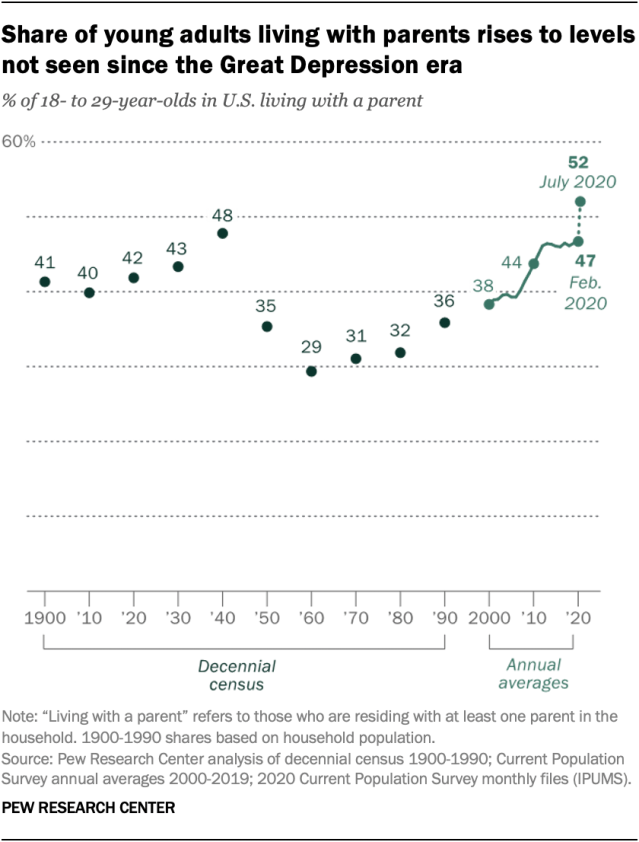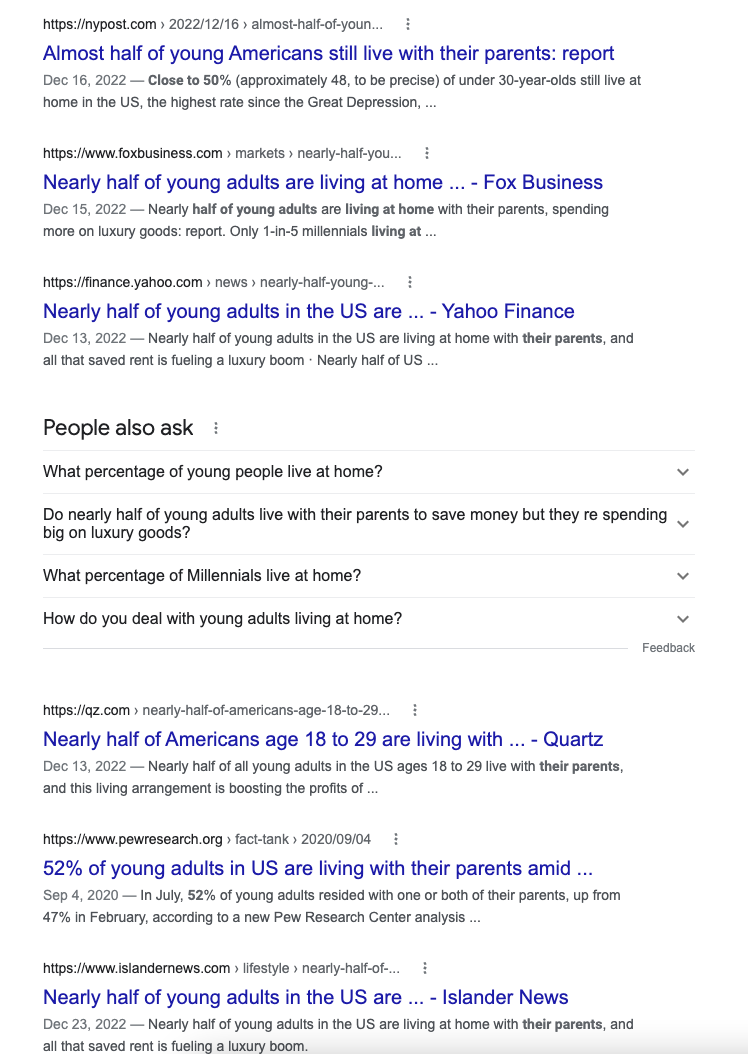Continue Reading
Biggest Finance Newsletter for Women
Join 200,000 other people interested in money, power, culture, and class.
Subscribe
A meme recently circulated on social media that had people in a tizzy: It claimed 52% of young adults live with their parents.
If this is the first time you’re learning of this bewildering statistic, you’re probably jumping to one of two conclusions:
-
The “cupcake trophy generation” clearly can’t hack it without mommy and daddy; if they’d stop getting degrees in underwater basket-weaving and YOLOing it up in Europe, they could hurry up and be miserable like the rest of us.
-
The system is broken to the point that the most educated, most in-debt generation of all time can’t make ends meet; things are f***ed beyond repair and we need to blow the whole thing up and start over.
…Or, maybe, you had a third reaction: Incredulity. Could this really be true? These numbers seem too high.
Some responses to the meme pointed out that the numbers could be skewed for several reasons, including people whose parents live with them (as in, the child is a caretaker). Others noted that “young adults” includes college students, who would be smart to live at home rather than paying an outrageous amount to live on campus.
Still, others went back a step and asked, “Why have we decided this is a bad thing?” Shipping out of the nest at age 18 (or else you’re a failure!) is not a global expectation; multigenerational living is normal and culturally prevalent outside the US.
My first question: What even constitutes “a young adult”?
But before we start spiraling, let’s ask ourselves an important question: Is this claim legitimate? And if it is, why?
Where does the data come from? Let’s dig in.
The first stop on our investigative journey is to check the Pew Research Center, since they have the ~historical context~:
For starters, we now have a more substantive, specific definition of “young adults”: 18 to 29 years olds.
In the chart above, we can examine 120 years of data about the living situations of 18-29-year-olds in the US. Between 1900 and 1930, the number of young adults living at home hovers in the low-40% range, and spikes at 48% in 1940 (during World War II).
A steep dropoff follows, hitting a low point of 29% in the 1960s, and staying relatively low until climbing again in the 1990s.
Then, for the first time since WWII, numbers breached 40% in the 2010s.
They’ve remained high through today, reaching a new peak of 52% in July 2020, during… well, you know.
At a high level, it’s hard not to notice that the “spikes” of adult children living at home coincide with some of the diciest economic times (the Great Depression, the Great Recession, Covid-19).
(Pew is also careful to note that the way this data is captured has changed over time; it appears there were three different means of collection over the ~120 years shown. As with all conclusions that hinge on data, our hot takes can only be as valid and sound as the data itself.)
But trendlines aside, there’s one major nuance here that the headlines ignore:
All young adults are not created equal.
Because here’s the kicker: Most of the growth was generated by the youngest of young adults.
“2.1 million of the 2.6 million increase” in 18- to 29-year-olds was driven by 18- to 24-year-olds, the same cohort that’s more likely to be found still in school. Per Pew, “Among all adults who moved due to the pandemic, 23% said the most important reason was because their college campus had closed, and 18% said it was due to job loss or other financial reasons.”
When you segment the 18- to 29-year-old group into 18- to 24-year-olds and 25- to 29-year-olds, the picture looks completely different: The growth for the older crew increased from 26% in February 2020 to 28% in July 2020—a far cry from the “52% of young adults” blanket claim.
Age differentiation feels important, since the outraged crowd in the meme comments seemed to picture Brennan and Dale building adult bunk beds when they’re claiming young adults have no desire to be independent anymore:

And while things seem (?) to be “normalizing,” what if “normal” might still be bad?
A USA Today fact check from late 2021 noted that the number had begun dropping again back down to around 47%, which is more in line with pre-pandemic numbers.
But 47% is still—historically—high.
And what’s been most interesting is the way the media has run with this story—that “HALF OF AMERICANS AGED 18 TO 29 LIVE WITH THEIR PARENTS!”—assigning a more damning narrative. Several of the articles (like this one from Yahoo! Finance, and this one from Fortune) even claim that young adults are living at home so they can buy Chanel bags and flex on their friends, though the relationship between the two data points is tenuous at best.
>
“Several articles even claim that young adults are living at home so they can buy Chanel bags and flex on their friends, though the relationship between the two data points is tenuous at best. ”
The logic posited is, “Young people are living at home at record rates and luxury goods sales are rising among young people; ergo, young people are living at home because/so they can buy luxury goods,” which is weird, considering later in the same Yahoo! Finance article, it states that 51% of young adults say they’re living at home so they can save money and 39% of them say it’s because they can’t afford rent.
To be fair, these outlets are just reporting what banks like Morgan Stanley are telling them: “We think the structural change in demographics might have been overlooked,” said analyst Edouard Aubin. “One of the key demographic trends in the US (and the broader Western market) has been the rising number of young adults living with their parents, driven by financial concerns (i.e., rental costs) as well as other sociological factors (e.g., higher penetration of higher education and increasingly delayed age for marriage).”
But as we covered just a few weeks ago, the richest young people are richer than any other cohort of young people in history—there’s no evidentiary support for the idea that the quarter or so of 25- to 29-year-olds who are living in their childhood bedrooms are also the group pumping up the price of Gucci slides.
Though that’s certainly the story the media seems to be running with, evidence be damned: A quick Google search reveals that this statistic is—more often than not—paired with a convenient addendum about the “luxury boom.”
But it’s probably untrue that “kids these days” just prefer being gig workers without health insurance who live with their parents…
We have a tendency to attribute these circumstances to personal preference: “Young people these days are just so different than young people of the past! They don’t want to be independent! They don’t want to work! They don’t want to have a house of their own!”
But as our interesting trend line shows us, ‘young adults living at home because they literally can’t afford not to’ seems a fairly accurate barometer for how dire our economic situation is.

In a culture where living with your parents as an adult is not the norm, it stands to reason this isn’t the default first choice for people in their twenties.
It’s probably not individual behavior, changes in generational preferences, or slippery cultural phenomena that are responsible for these massive, demographic-wide shifts at the aggregate.
Instead, it’s probably just the result of a much more boring, much sadder story: a worsening economic reality.
And if we want things to improve, blaming luxury handbags and adult bunk beds probably isn’t the solution. Rather, we can examine the types of policy decisions in decades past that were associated with lower rates of “adult children living at home with their parents” for answers—especially since this group is most vulnerable to changes in the labor market, as entrants with low capital but high potential.
One thing is for sure: 47% of young adults aged 18 to 29 may live with their parents today, but trust me, it’s complicated.
February 27, 2023
Looking for something?
Search all how-to, essays, and podcast episodes.
Explore
While I love diving into investing- and tax law-related data, I am not a financial professional. This is not financial advice, investing advice, or tax advice. The information on this website is for informational and recreational purposes only. Investment products discussed (ETFs, index funds, etc.) are for illustrative purposes only. It is not a recommendation to buy, sell, or otherwise transact in any of the products mentioned. Do your own due diligence. Past performance does not guarantee future returns.
Money with Katie, LLC.
Terms & Conditions | Privacy Policy
This Site Was Built by Brand Good Time





